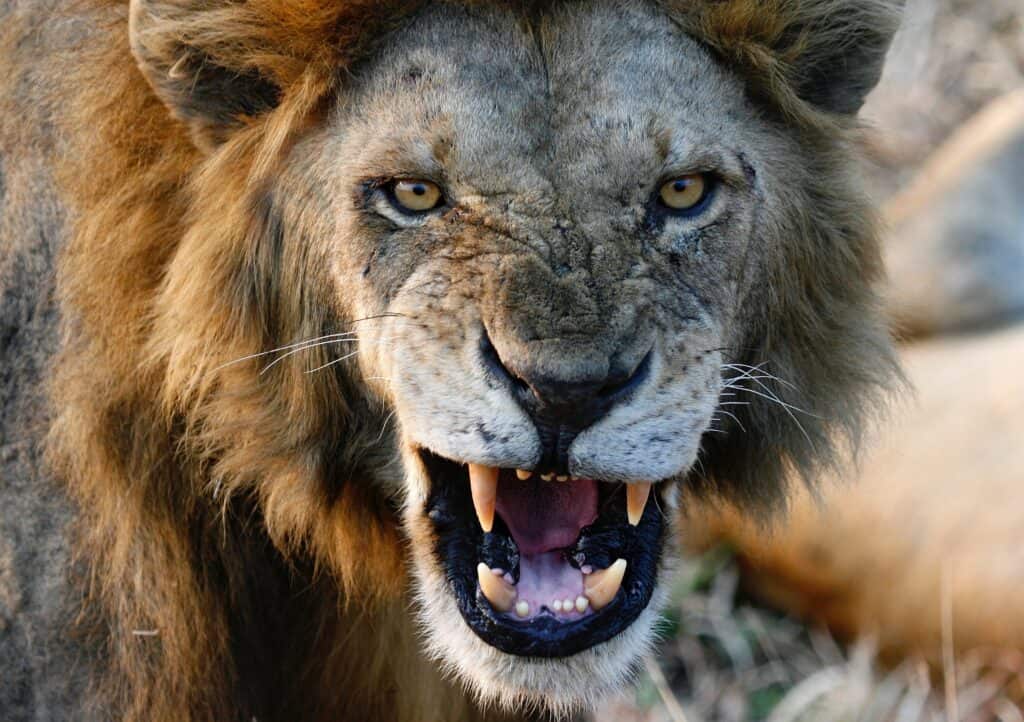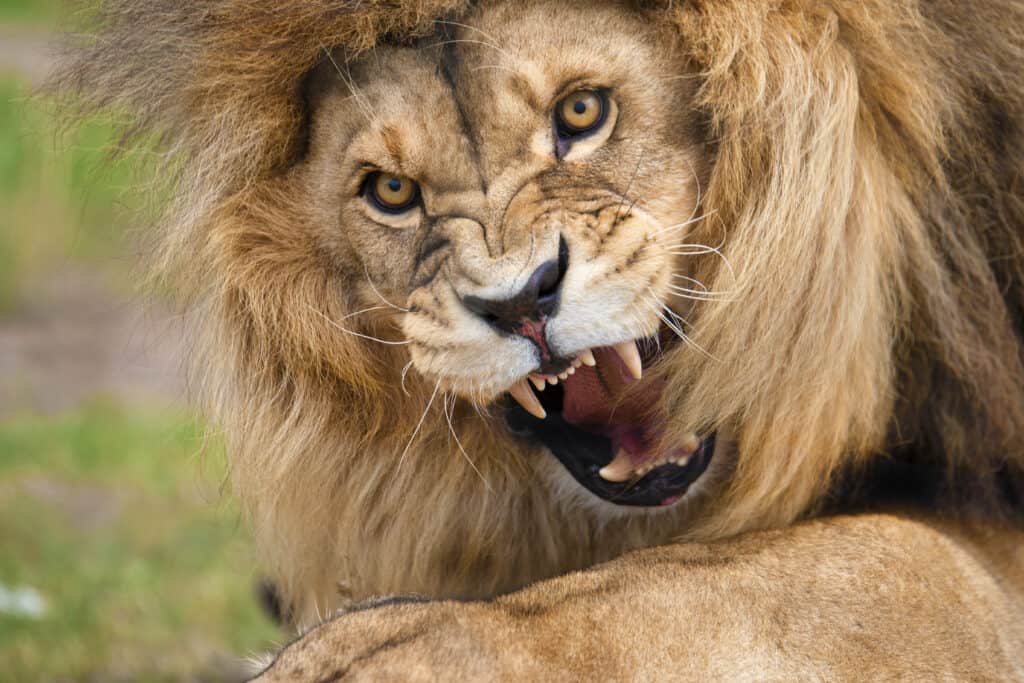The cat family (family Felidae) is a large and diverse one. It includes big cats like the lion and tigers, medium-sized cats like the lynx and caracal, and small cats like domesticated house cats. The size difference aside, big cats like lions are similar to domestic cats in many ways. They both have whiskers, they are carnivorous, and they can be very territorial. They also share identical body morphology. But as closely related as they are, distinct differences exist between them. One such subtle difference is that lion eyes don’t look like cat eyes.
Lions typically have round pupils, while domestic cats have narrow vertical ones resembling daggers. The domesticated cat eye seems to be the standard in small cats, while big cats like lions and tigers tend to have round pupils.
Despite these differences, there are still certain similarities between the eyes of both felines. For a start, they both have better vision than humans, and their eyes also reflect light at night, producing a scary glow. The young of both species are blind at birth. Considering all these similarities, why do lion and cat eyes come in different shapes? Read on to find out.
Why Lion Eyes Don’t Look Like Cat Eyes

Lions have round pupils.
©Kit Korzun/Shutterstock.com
Unlike cats with vertical slits, lions have round pupils. No one knows for sure why this is so, but scientists have put forward a persuasive theory to explain the differences in the eyes of both felids. Basically, lion eyes don’t look like cat eyes because they are bigger. They hunt prey differently and are more active during the day than at night.
Martin Banks, a professor of optometry at UC Berkeley, conducted extensive research on this subject to answer the question of the difference in eye shape in different animals. The study, carried out in collaboration with Durham University in the United Kingdom and published in the Science Advances journal, presents a hypothesis that links eye shape to the ecological niche occupied by an animal.
For the study, Banks and his colleagues analyzed 214 land animals. The scientists correlated these animals’ eye shapes (round, horizontal, and vertical) to their lifestyle in terms of how they forage for food and the time of the day they were more active.
Based on this research, the main reason the eyes of lions don’t look like that of small cats is their place in the ecosystem. The researchers discovered that taller animals that chase prey, such as lions, tigers, and wolves, tend to have round pupils.
Conversely, The small cats had vertical slit pupils because they were more likely ambush predators. Their small size means they cannot chase prey actively like the big cats. Instead, they hunt by stealth.
Size, Stealth Hunting and Eye Shape
For animals that hunt by stealth, focus is very important. Shorter predators like cats and crocodiles naturally need eyes with better focus because they have to get closer to their prey to make a catch. Scientists found that eyes with slit pupils were the perfect adaptation to make this possible. Slit eyes allow ambush predators to judge distance accurately through two optical processes called stereopsis (or depth perception) and blur.
Stereopsis is an adaptation that allows the brain to perceive information from each eye at slightly different angles. At the same time, blur refers to the difference in sharpness of objects at different distances from the eye. These two phenomena make it easier for small cats to accurately estimate the distance between them and their prey.
Big cats don’t need these adaptations. They simply muscle their way through the hunt by chasing prey over a distance and leaping at them. Out of 65 ambush predators included in Banks’ study, 44 had vertical pupils, and 36 of these were less than 16.5 inches tall at the shoulder.
However, there are exceptions to the rule. Not all short predators have vertical slit pupils. A good example is the Pallas cat. The wild cat species is weird in the sense that it has round eyes even though it is the same size as a regular house cat. The reason why it is so is still a mystery, and no one can give a conclusive explanation yet. However, since small cats with round eyes were outliers, the hypothesis that links slitted eyes to small size seems valid.
Lions Are More Active During the Day

Since lions can hunt during the day, they really don’t need specialized eye structures to let in more light.
©Shawn Levin/Shutterstock.com
The other hypothesis is that lions have round eyes because they are usually more active during the day than cats. The pupils of the eye function like the aperture of a camera. It regulates the amount of eye that enters the eye by either dilating (opening) or constricting (closing).
Circular pupils like that of a lion have ring-shaped muscles to control how well they open and close, while vertical slit ones like the cat’s have muscles on the sides. The result is that the cat’s pupils open and close more strongly, allowing a larger change in size at night to let more light in. Researchers believe this ability helps the cat see more in dim light.
Since lions can hunt during the day, they really don’t need specialized eye structures to let in more light. Even without slit pupils, lions still see clearly at night thanks to other adaptations, such as a reflective layer of cells behind their retina known as tapetum lucidum. It acts like a mirror and helps the animal see better in the dark.
Other Interesting Facts About the Lion’s Eyes
- Lions can have blue eyes: Lions have beautiful round brown amber eyes. White lions (lions without the usual lion pigment) have characteristic pale brown eyes. However, in some rare cases, lion eyes are blue instead of their typical characteristic color.
- Lions can’t see some colors: The retina of a typical lion contains more rod cells. The ratio of the rod to cone photoreceptor cells in the lion is 25:1. The rod cells are the reason the animal has better sight in low light. The cone cells, on the other hand, help an organism distinguish colors. The big cat has only the cones for blue and yellow light. The implication of this is that lions cannot differentiate red light effectively.
- Lions have an extra eyelid: This additional layer, called the nictitating membrane, provides extra protection to the cornea. The cornea is located in the front of the eye, and it directs light toward the retina in the back. The nictitating membrane prevents dust from entering the lion’s eye. Also, it keeps the eye moist, which is necessary for optimum vision.
- Lions are born blind: Like kittens, lion cubs are blind at birth. It takes about four days before they gradually start to regain their sight. This makes them highly vulnerable and entirely dependent on their mothers.
Conclusion
We still do not fully understand the main reason animals have different eyes. The underlying cause seems to be more than mere feeding technique and whether the animal is nocturnal or diurnal. Regardless, there are high hopes that more focused research will give more plausible and acceptable explanations.
Up Next
The photo featured at the top of this post is © Michael Zeitner/Shutterstock.com
Thank you for reading! Have some feedback for us? Contact the AZ Animals editorial team.







